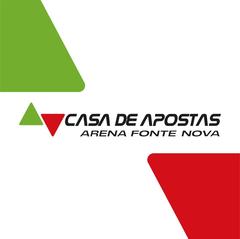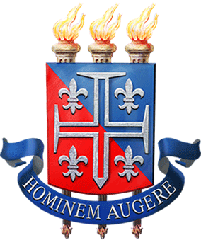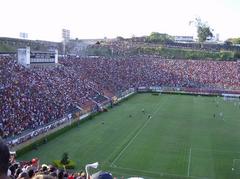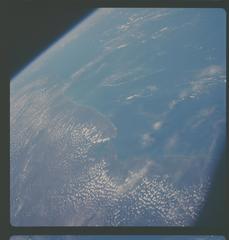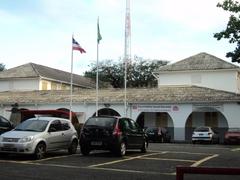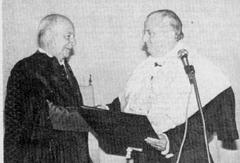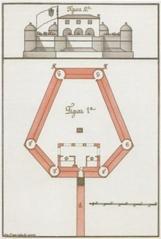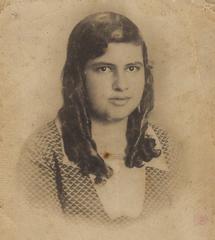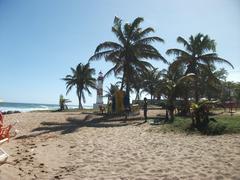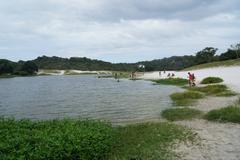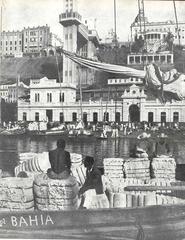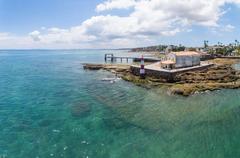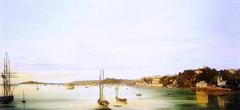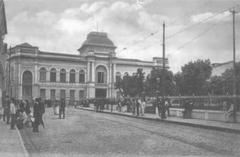Museum of Sacred Art Salvador, Brazil: Visiting Hours, Tickets, and Visitor Guide
Date: 04/07/2025
Introduction
Nestled in the heart of Salvador’s UNESCO World Heritage-listed historic center, the Museum of Sacred Art (Museu de Arte Sacra) stands as a beacon of Brazil’s religious and artistic legacy. Housed within the 17th-century Convent and Church of Santa Teresa, the museum offers an immersive journey through centuries of sacred art, reflecting the confluence of European, African, and Indigenous influences that have shaped Bahia’s spiritual and cultural landscape. Home to one of the largest collections of colonial sacred art in Latin America, the museum preserves and showcases masterpieces of Baroque sculpture, painting, liturgical silverwork, azulejos (tiles), and religious textiles. This comprehensive guide provides essential information on visiting hours, ticketing, accessibility, highlights of the collection, guided tours, and nearby attractions for anyone planning to experience Salvador’s sacred art heritage (bahia.ws, Museu de Arte Sacra da UFBA, PlanetWare, Visit Salvador da Bahia).
Contents
- Historical Background and Evolution
- Architectural and Cultural Significance
- Visiting Information: Hours, Tickets, and Accessibility
- Collection Highlights
- Guided Tours and Visitor Tips
- Nearby Attractions
- Community Engagement and Legacy
- FAQs
- Summary and Further Exploration
- References
Historical Background and Evolution
Origins and Foundation
The Museum of Sacred Art is rooted in the Convent and Church of Santa Teresa, founded in 1665 by the Discalced Carmelites and completed in 1697. Originally serving as a religious and charitable center, the complex is a landmark of colonial Salvador. In 1959, during the IV International Colloquium of Luso-Brazilian Studies, the convent was transformed into the Museum of Sacred Art, spearheaded by the Federal University of Bahia (UFBA) and the Archdiocese of Salvador. Early collections came from the demolished old Sé Cathedral and other local institutions (bahia.ws).
Collection Growth
Over the decades, the museum has expanded its holdings through donations, loans, and acquisitions, including contributions from private collectors and religious orders. Today, it boasts over 5,000 artifacts spanning the 16th to 20th centuries, making it the largest and most comprehensive collection of sacred art in Brazil (Visit Salvador da Bahia).
Academic and Cultural Role
Administered by UFBA, the museum is an active center for research, education, and cultural outreach. It regularly hosts scholarly events, workshops, and exhibitions, fostering interdisciplinary dialogue on art, faith, and history (Museu de Arte Sacra da UFBA).
Architectural and Cultural Significance
The Convent and Church of Santa Teresa
Located in Salvador’s upper city (Cidade Alta), the Convent and Church of Santa Teresa is a masterpiece of Portuguese colonial religious architecture. Construction began in 1666, with the church’s façade modeled after the Gesù Church in Rome, featuring elegant Baroque symmetry, a triangular pediment, and pilasters. The complex’s internal cloisters, arcaded galleries, and stone columns create a tranquil, contemplative environment (PlanetWare, Ibn Battuta Travel).
Interior and Decorative Elements
The nave is adorned with gilded woodwork, polychrome statues, and intricate altarpieces. Notable works include the cedarwood “Christ in Chains” by Francisco Manuel das Chagas (O Cabra), set with over 1,000 rubies, and paintings by renowned artists like José Joaquim da Rocha, Agostinho da Piedade, and Agostinho de Jesus (PlanetWare).
Adaptive Reuse
The transformation of the convent into a museum preserves the architectural integrity while making its treasures accessible to the public. The galleries are integrated into the former monastic spaces, allowing visitors to experience the interplay between art, architecture, and spirituality (World Cities Ranking).
Visiting Information: Hours, Tickets, and Accessibility
Location
- Address: Rua do Sodré, 276, Centro, Salvador, Bahia, Brazil.
- How to Get There: Walking distance from Pelourinho; accessible via public transport, taxis, and ride-sharing.
Opening Hours
- Tuesday to Friday: 11:30 AM – 5:30 PM
- Saturday: 1:00 PM – 5:00 PM
- Closed: Sundays, Mondays, and public holidays
- Note: Hours may vary seasonally; check the official website before your visit.
Tickets
- General Admission: R$10 (approx. USD 2)
- Discounts: Available for students, seniors, and children
- Free Admission: Often on the first Saturday of each month and children under 12
- Ticket Purchase: At the entrance or through the official museum website
Accessibility
While the historic nature of the building presents challenges, ramps and elevators have been installed in some areas. Visitors with mobility needs are encouraged to contact the museum in advance for assistance.
Facilities
- Restrooms
- Gift Shop: Religious art reproductions and local crafts
- Courtyard: Tranquil space for reflection
Collection Highlights
Paintings
- Baroque and Rococo Panels: Dramatic religious scenes with gold leaf and emotive iconography
- Works by José Joaquim da Rocha: Including “A Última Ceia” (The Last Supper), central to Bahian baroque painting (Enciclopédia Itaú Cultural)
Sculpture
- Cedarwood “Christ in Chains”: 1710 masterpiece by O Cabra, adorned with rubies
- Polychrome Wood Sculptures: Saints, angels, and processional figures
Sacred Silver
- Silver Monstrance: Weighing over 10 kg, encrusted with precious stones (UFBA News)
- Chalices, Censers, and Reliquaries: Crafted by colonial goldsmiths
Azulejos and Ceramics
- Portuguese and Spanish Tiles: 17th–18th centuries, depicting saints and biblical scenes
Textiles
- Embroidered Vestments and Banners: Silk and gold thread, Marian symbols, and Afro-Brazilian motifs
Cloister
- Santa Teresa Cloister: A contemplative architectural highlight, often used for displaying sculpture (Salvador Turismo)
Guided Tours and Visitor Tips
- Guided Tours: Available in Portuguese; English/Spanish tours by prior appointment
- Audio Guides: Offered for deeper context
- Best Times: Weekday mornings for a quieter visit
- Visit Duration: 1.5–2 hours recommended
- Photography: Allowed without flash in most areas; restrictions apply to some artifacts
- Attire: Respectful dress is encouraged
Nearby Attractions
- Pelourinho Historic District: Colonial architecture and lively streets
- São Francisco Church: Baroque masterpiece nearby
- Elevador Lacerda: Iconic city elevator with panoramic views
- Mercado Modelo: Market for crafts and local food
Community Engagement and Legacy
The museum is dedicated to preserving and interpreting Brazil’s religious and multicultural heritage, with educational outreach, research, and collaborations with local communities. Its exhibitions increasingly include Afro-Brazilian and Indigenous perspectives, reflecting Salvador’s diverse identity (sapirjournal.org).
Frequently Asked Questions (FAQ)
Q: What are the opening hours?
A: Tuesday to Friday, 11:30 AM–5:30 PM; Saturday, 1:00–5:00 PM; closed Sundays, Mondays, and holidays.
Q: How much are the tickets?
A: R$10, with concessions for students, seniors, and children; free on certain days.
Q: Is the museum accessible?
A: Some areas have ramps and elevators; contact the museum for assistance.
Q: Are guided tours available in English?
A: Yes, by prior arrangement.
Q: Can I take photos inside the museum?
A: Non-flash photography is generally allowed; check for restrictions.
Q: Are there special exhibitions?
A: Yes, the museum hosts regular temporary exhibitions, concerts, and workshops.
Summary and Further Exploration
The Museum of Sacred Art in Salvador invites visitors to engage with centuries of faith, artistry, and cultural exchange. Its unparalleled collection—housed within an architectural jewel—offers insight into Brazil’s colonial past and the ongoing dialogue between tradition and modernity. Whether you are admiring Baroque masterpieces, exploring tranquil cloisters, or joining a guided tour, your visit will deepen your appreciation of Salvador’s spiritual and artistic heritage. Pair your museum experience with visits to other historic sites and use digital resources like the Audiala app for enhanced tours and updates. Embrace the chance to immerse yourself in the sacred art and living history of Salvador (bahia.ws, Museu de Arte Sacra da UFBA, PlanetWare).
References
- Museum of Sacred Art in Salvador: Visiting Hours, Tickets, and Historical Insights (bahia.ws)
- Visiting the Convent and Church of Santa Teresa in Salvador: Hours, Tickets, History, and Highlights (PlanetWare)
- Museu de Arte Sacra Salvador: Visiting Hours, Tickets & Highlights of Sacred Art (Museu de Arte Sacra da UFBA)
- Museum of Sacred Art Salvador Visiting Hours, Tickets, and Visitor Guide (Museu de Arte Sacra da UFBA)
Images for illustration:
For more travel tips, guides to Salvador historical sites, and updates on events, explore our related articles and download the Audiala app.
